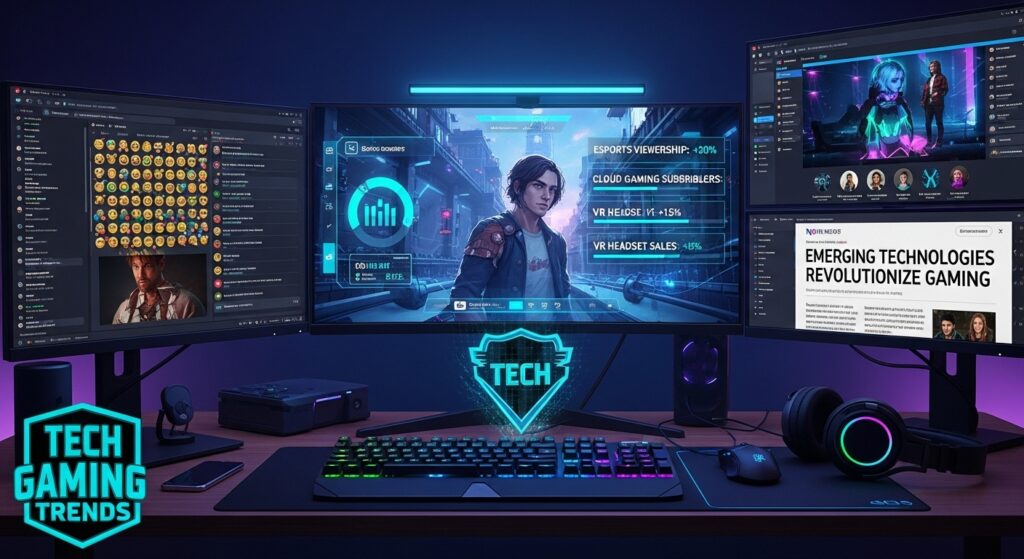Introduction
The world of gaming is evolving faster than ever, and at the heart of this transformation lies Tgarchirvetech gaming trends — a term that captures the fusion of technology, architecture, and virtual innovation shaping how we play. From AI-powered environments to hyper-realistic graphics and cloud-based experiences, Tgarchirvetech symbolizes the next frontier in the digital entertainment revolution. These trends are not just reshaping gameplay; they’re redefining the entire gaming ecosystem, influencing design, storytelling, community engagement, and monetization.
In 2025, gaming is no longer a hobby; it’s a multibillion-dollar global industry. According to Statista, the video game market is projected to surpass $360 billion by 2027, driven by technological breakthroughs and user demand for immersive, personalized experiences. Tgarchirvetech gaming trends bridge this demand by integrating next-gen tools — such as augmented reality (AR), virtual reality (VR), blockchain, and AI — to create virtual worlds that feel alive.
But beyond the tech, these trends represent a shift in how gamers interact, compete, and connect. Whether it’s esports arenas powered by advanced analytics or indie developers leveraging metaverse frameworks, Tgarchirvetech innovation is rewriting the rules. This article explores how these emerging trends are influencing game design, player engagement, digital economies, and the future of interactive storytelling.
The Rise of Immersive Architecture in Gaming
The foundation of Tgarchirvetech gaming trends lies in immersive architectural design. Game worlds are no longer flat landscapes; they’re intricately built ecosystems inspired by real-world structures and imaginative realms. Developers now employ architectural visualization techniques to craft environments that feel authentic, from cyberpunk cities glowing with neon reflections to medieval castles rendered with ray tracing. This fusion of architecture and gaming has created digital spaces where players not only play but live virtually.
Titles like Cyberpunk 2077 and Assassin’s Creed Valhalla highlight this intersection beautifully. Designers incorporate spatial storytelling—using buildings, light, and sound—to guide player emotions and exploration. Tgarchirvetech’s emphasis on digital architecture is also shaping virtual real estate in metaverse platforms, where users can buy, build, and customize their own environments. These virtual structures blur the line between gaming and digital ownership, creating new economies within immersive spaces.
Artificial Intelligence and Adaptive Gameplay
AI has become the backbone of modern gaming innovation. Tgarchirvetech gaming trends heavily rely on machine learning to enhance user experience, personalize difficulty levels, and create more lifelike NPCs. Games such as The Last of Us Part II or Red Dead Redemption 2 showcase adaptive enemy behaviors, environmental changes, and dialogue systems that respond dynamically to player choices. AI-driven systems can even predict player intent, adjusting challenges or narratives for deeper immersion.
Beyond gameplay, AI powers the behind-the-scenes analytics that developers use to refine balance and engagement. Predictive algorithms assess how long players spend in certain levels, which in turn shapes future updates or expansions. Tgarchirvetech emphasizes this symbiosis between technology and creativity — using data not to constrain design, but to empower it. As AI grows more advanced, expect games to feel increasingly organic, where every decision creates a unique narrative thread.
Cloud Gaming and Accessibility Revolution
Accessibility is a cornerstone of Tgarchirvetech gaming trends. Cloud gaming has democratized access by allowing players to experience high-end games without expensive consoles or hardware. Platforms like NVIDIA GeForce Now, Xbox Cloud Gaming, and Amazon Luna exemplify this shift, enabling users to stream titles directly from powerful servers to any device. This not only expands reach but also opens gaming to global audiences previously limited by cost or geography.
From an industry perspective, cloud gaming eliminates traditional distribution barriers. Developers can deploy instant updates, cross-platform compatibility, and seamless multiplayer experiences. Tgarchirvetech technologies ensure reduced latency and real-time synchronization, improving gameplay quality even over average internet connections. This evolution aligns with the global push for inclusivity, making interactive entertainment more accessible to millions of players worldwide.
The Influence of Esports and Competitive Gaming
Esports continues to dominate the entertainment landscape, and Tgarchirvetech gaming trends amplify its growth through advanced tech integration. Competitive gaming has evolved into a global spectacle with professional leagues, sponsorships, and multimillion-dollar tournaments. Games like League of Legends and Valorant thrive on Tgarchirvetech-driven analytics that track player performance, strategy, and fan engagement in real time.
This tech-driven analysis enhances both coaching and viewer experience. AI and VR training simulators allow athletes to refine precision and teamwork in controlled environments. Meanwhile, audiences enjoy interactive broadcasts, where real-time stats and augmented visuals enhance storytelling. The Tgarchirvetech approach to esports bridges performance science with entertainment, setting the stage for an era where competition is as much about data as it is about skill.
Blockchain, NFTs, and the Gaming Economy
Digital ownership has become a defining feature of modern gaming. Tgarchirvetech gaming trends leverage blockchain technology to establish transparency, security, and authenticity in digital assets. Non-fungible tokens (NFTs) allow players to own unique in-game items, from rare skins to collectible avatars. This transforms the player experience into an economy of creativity and ownership, empowering gamers to trade, sell, and invest in digital goods.
While the NFT craze has cooled, developers are adopting more sustainable blockchain solutions that focus on utility over speculation. Games like Illuvium and Star Atlas showcase how decentralized frameworks can coexist with traditional game models. Tgarchirvetech encourages responsible adoption—prioritizing environmental consciousness and user value—to ensure blockchain integration enhances rather than exploits the gaming ecosystem.
The Role of Augmented and Virtual Reality
AR and VR are central pillars of Tgarchirvetech gaming trends, reshaping sensory engagement and immersion. Virtual reality headsets like Meta Quest 3 and PlayStation VR2 offer players fully interactive environments that respond to movement and voice. Augmented reality, on the other hand, brings gaming into the real world, merging digital characters with physical surroundings—think Pokémon GO or Minecraft Earth.
These technologies redefine what “playing” means. VR fitness titles, AR-based puzzle adventures, and educational simulations merge entertainment with experiential learning. Tgarchirvetech integrates these systems to enhance realism, emotion, and connection. As hardware becomes more affordable and ergonomic, AR/VR gaming is expected to grow exponentially, leading to entirely new genres and interactive possibilities.
Sustainability and Ethical Innovation
With great technological advancement comes responsibility. One of the more understated Tgarchirvetech gaming trends is sustainability—both environmental and social. Studios are embracing green game development by optimizing energy consumption and reducing data center emissions. Initiatives like the UN’s Playing for the Planet Alliance showcase industry-wide commitment to eco-friendly production and awareness campaigns.
Ethical innovation also plays a critical role. Issues of inclusivity, representation, and online safety are shaping how developers design interactive spaces. Tgarchirvetech prioritizes diversity, accessibility, and player well-being, ensuring that the future of gaming remains inclusive and responsible. This balance between innovation and ethics defines the next era of digital entertainment.
Conclusion: The Next Level of Tgarchirvetech Gaming
Tgarchirvetech gaming trends represent more than just a technological movement—they mark a cultural transformation. From immersive architecture and AI-driven gameplay to blockchain economies and VR innovation, the fusion of technology and creativity continues to redefine what gaming can be. As the boundaries between reality and virtuality blur, players are no longer just participants—they’re co-creators in evolving digital worlds.
The future of gaming will depend on how effectively we harness Tgarchirvetech’s potential to create meaningful, sustainable, and inclusive experiences. Whether you’re a developer, gamer, or investor, now is the moment to embrace this convergence and explore what’s next. The Tgarchirvetech revolution isn’t just coming—it’s already here, reshaping the way we play, connect, and imagine.







